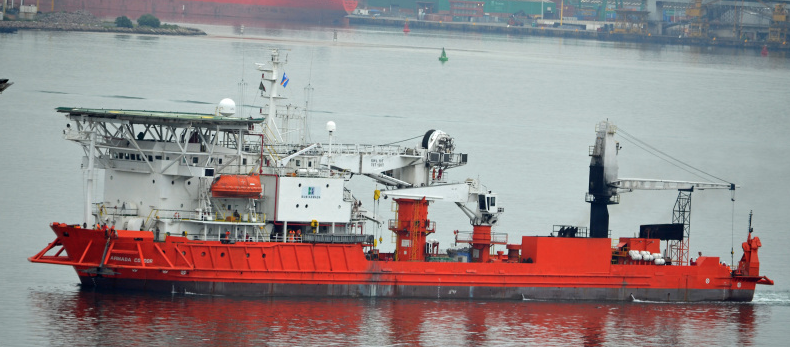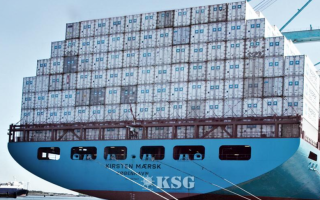Reefer market structure, from Russia to Africa
For bloggers
Do you want to manage all news about Reefer Ships in Russian African routes?. Contact us here mayado@sylodium.com
For companies
Make business in all bilateral trades. Specially from Russia to Africa about Videogames and Reefer Ships.
For Institutions
Tap Sylodium if you are in Russian - African institutional relations (contact us for synergies)
This new is from PortTecnhology.org
Dynamar: Reefer Box Production Collapses
A side effect of cheap oil
With the oil price still at a historically low level combined with low scrap prices, demolition of conventional reefer ships dropped to a very low level. Only those vessels unfit for further trading, usually over thirty years old, fell victim to the torch. It was five average 423,000 cft-units in 2015, increasing to ten last year. If the present trend to higher oil prices persists, scrapping may well pick up further again in 2017.
A reefer ship orderbook? It exists!
By the end of 2016, the reefer ship-orderbook counted a relatively healthy sixteen units, with their capacities ranging between 120,000 and 650,000 cft. Most, if not all of the smaller, up to 350,000 cft, units will be for the fisheries trades, including four on order by Seatrade. Just four vessels are of the largest sizes and assumed all to be for Star Reefer. The Anglo-Norwegian company itself has so far confirmed only two of them of which the first delivered in very early days of 2017.
A continuously shrinking vessel armada
With the average age rising and an overall restricted newbuilding activity, the conventional reefer ship fleet continues its decline, although now slowed somewhat by the current orderbook and the four ships delivered in 2016. Yet, by 2025, ships built before 1995 will reach the average scrapping age of 30, altogether causing the fleet to fall by around 35% to some 400 units.

...And a slower growing box fleet
Completely against the trends of previous years, at an estimated 135,000 TEU, the 2016 production of reefer boxes halved as compared to the year earlier. It may be considered a reflection of the signalled weakening reefer trade environment with the single advantage of a lack of equipment shortage.
Seatrade kicks off
Just when the “Dynamar 2016 REEFER Analysis” went to press, Seatrade Chartering announced the January 2017 launch of a new, 10-day frequency, reefer-heavy full container service, styled Meridian. It is the first operation in which it will deploy its purpose-built newbuildings. The first four of an initial order for six have meanwhile been delivered, with the remaining two following shortly. Chartered units will initially complement the planned 8-ship Meridian flotilla.
All six 27,200-dwt ships have a nominal capacity of 2,250 TEU and are fitted with 670 to 770 (the last two) reefer plugs. This means that at a full load of 40’ High Cube reefer containers filled to their maximum allowed payload, the four 670-plug vessels could still accommodate an additional 120 TEU of dry cargoes. The maximum gross weight of a full load of laden 40’ High Cubes alone would exceed the deadweight capacity of the two ships with 770 installed plugs.
Meridian FDD (Fast, Direct, Dedicated) will connect 11 ports spread over New Zealand, Peru, USA, Europe and the South Pacific. The rotation will be as follows: Nelson, Napier, Tauranga, Callao, Paita, Philadelphia, Zeebrugge, Dover, Rotterdam, Dunkirk, Radicatel, before returning via the Panama Canal, Papeete and Noumea back to Nelson. Representing an 80 day-roundtrip, it is quite a world trip, albeit not around...
Meridian definitely represents a major happening: the world’s largest conventional reefer ship operator goes containers...! Ultimately, and as part of the company’s 2020 fleet renewal programme, the number of similar container ships should grow to twenty, i.e. another fourteen to go, therewith replacing most of its current largest conventional vessels.
That said, container ships are not new to Seatrade. At present it operates eight box ships of between 1,100-2,500 TEU with 250 up to 500 plugs in two different services: Agadir (Morocco)-St Petersburg and Caribbean-North Europe, the latter operated by subsidiary StreamLines.
Staying with containers
In the last quarter of 2016, 872 reefer heavy ships accepting containers operated 133 different South-North services originating in Latin America, Africa or Australasia. This represented a weekly capacity of 488,000 TEU along with the onboard availability of 71,000 reefer plugs. Apart from some smaller differences, the overall operated capacity, in terms of slots and plugs, remained largely unchanged in comparison to 2015. It is the first time in years this happening.
The (theoretical) annualised refrigerated capacity of all these reefer heavy South-North container services can be calculated at a rounded 9.0 billion cft. This compares to the ditto 1.3 billion cft capacity of the current conventional fleet. I.e., containers exceed conventional capacity nearly 7-fold.

The largest operators
Despite its serious flirt with containers, at the same time Seatrade Reefer Chartering continuous to be the largest conventional reefership operator with an, albeit reduced fleet of 56x 527,500 cft average ships. Baltic Reefer including its subsidiary Cool Carriers comes second with 42 units/590,000 cft average, followed by Lavinia-controlled Frigoship Chartering: 33/351,000.
In the container segment, measured by reefer plugs on ships operated on the South/North routes, Maersk Line is, again, the number one with 115,000 plugs. MSC comes second with 86,000 devices, having Hamburg Süd sitting on its heels with 79,000 such connections. Combined, Maersk Line and its future subsidiary Hamburg Süd operate 195,000 reefer plugs on the South/North routes, equal to a relevant share of 36%!
No reefer report without reefer ports
Dynamar’s Reefer Analysis highlights well over 120 reefer ports in more than 40 countries, detailing a wealth of data such as main perishables and volumes handled, annual reefer ship calls, total port throughput, number of terminal plugs, draught, and so on.
Issued mid-December 2016, DYNAMAR (2016) Reefer Analysis: Market Structure, Conventional, Containers (author: Frans Waals), is Dynamar’s latest report on worldwide perishable shipping using conventional reefer vessels or refrigerated containers on box ships.
It uses the most recent trade statistics on reefer commodity data by country and area, supplemented with up-to-date port, vessel, box and carrier fleet statistics and gives a profound insight into the background, characteristics, goings and present status of the worldwide perishables shipping market and its most relevant players. The 255-page report contains over 240 tables and 80 figures.
Features of Dynamar (2016) REEFER Analysis - Market Structure, Conventional, Containers include:
Reefer market structure(s)
- Historical overview of the background and development of reefer shipping
- Transport modes and characteristics - temperature settings - modern techniques - reefer box technology
- The world perishable trades: volumes by main produce and export regions
- The world’s main import regions: United States, European Union, Russia, China and Japan
- Trading patterns: conventional ships versus container vessels - main export areas - exports by product and individual country
- Major reefer ports: perishable exports by country - description of relevant reefer handling facilities by mode of transportation - port throughput statistics

Conventional reefer shipping
- Reefer trade developments covering the last three seasons (2016-2014), statistics and graphs, time charter equivalents
- Extensive conventional reefer ship overviews and statistics (existing IMO-registered fleet, orderbook, age profile, demolition, future development)
- Identically structured profiles of the world’s 15 largest conventional reefer ship operators, including markets/trade lanes served and their operated fleet (whether owned or chartered)
Container reefer shipping
- Container fleet and orderbook, reefer TEU capacity, plug/capacity ratios by size category, total box fleet and refrigerated container fleet (share) by main carrier
- Main reefer box lessors, reefer machinery manufacturers and reefer container makers
- The reefer-heavy containership phenomenon; container heavy shipping services on the most relevant (South/North) reefer routes
- Unique: full details (services, carriers, ships, capacities, plugs) of all South/North container services
- Refrigerated container box fleet, size categories, production data, capacity by carrier
- Identically structured profiles of the world’s 15 largest reefer container carriers
Tables: 1) Russian perishable imports by origin
Explanatory text:
The boycott of Russia in response to sanctions levied on the country by the EU and the US from September 2014 onwards, in combination with lack of finance caused by the collapse in the price of oil caused a substantial fall of Russian imports. In 2015, its imports of perishables dropped by 28%, or 3,484,000 tons compared to 2013, the last “sanctions and boycotts-free” year. Alternative markets found could not sufficiently compensate for these losses. Until August 2014, before the start of the sanctions and boycotts, imports were well above 2013 levels.

Tables: 2) Top 10 conventional reefership operators
Explanatory text:
Combined, the world’s ten largest conventional reefer ship operators operate 233 (2015: 231) vessels comprising nearly 108 (109) million cubic feet of reefer space, equalling 54% of the world conventional reefership fleet. The biggest player is Seatrade whose 30 (30) million cft capacity constitutes a share approaching 15%. It is followed by Baltic Reefers including Cool Carriers (12%) and third Lavinia Corp’s Frigoship with 11.6 million cft or 6% of the top ten capacity.
Three perishables traders handling their own shipping needs are part of the conventional Top 10: Africa Express Line (Compagnie Fruitière), Great White Fleet (Cutrale/Safra-owned Chiquita) and Network Shipping (Del Monte). Traders outside the ranking include Fyffes, Cosiarma (GF Group), Dole Ocean Cargo Express (Dole), Ecuadorian Line (Bonita) and Isabella Shipping (Uniban).

Note: Capacity has been allocated to the carrier actually responsible for the long-term commercial operations of the ships
More tables can be made available upon request.
DYNAMAR (2016) Reefer Analysis: Market Structures, Conventional, Containers is immediately available and can be ordered for direct download under the link www.dynamar.com/publications/176 or by contacting Dynamar B.V.
About Dynamar
Since 1981, Dynamar B.V. has provided Transport and Shipping Information and Consultancy services for the Marine, Energy and Financial sectors. Dynamar today is world's leading container sector credit risk analyst and a major provider of analytical shipping news and commentary.
Whilst Credit Risk Assessment has remained its core business, Dynamar nowadays also specialises in:
Marine Intelligence, including Cargo and Vessel Tracking
Consultancy for the Liner, Container and Port industry, as well as on Dry and Liquid Bulk markets
Shipping Publications, spearheaded by the DynaLiners portfolio of daily, weekly, monthly and annual analytical news and commentary on the worldwide container trade. Dynamar Monthly Markets Monitor (MMM) is a 12x per year report on facts and trends in 5 main shipping segments
Publications among others comprise analyses on World’s 25 Largest Container Operators, Container Liner Trades and Markets reports, Ports and Terminals studies, as well as a variety of insight topics such as on Transhipment & Feedering, Breakbulk, Deepsea RoRo Shipping, Reefer Trades, Slow Steaming, Terminal Handling Charges and others.

